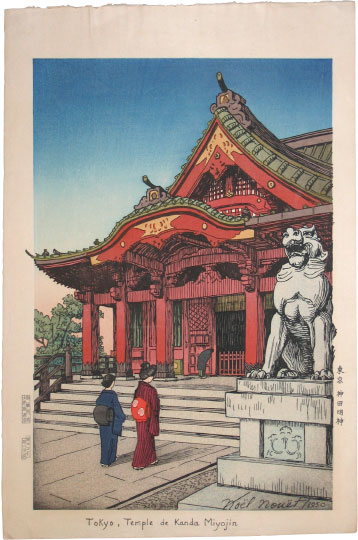

Noel Nouet
1885-1969
Scenes of Tokyo,Twenty-four Views: Tokyo, Temple de Kanda Miyojin
(Tokyo Fukkei Zen Nijuyon Mai: Tokyo, Kanda Myoji)
color woodblock print with zinc keyblock; signed within the composition along the bottom edge, Noel Nouet/1950, the title in Japanese on the right margin Tokyo Kanda Myojin, with publication information along the left margin, hanken shoyu Doi Hangaten (copyright Doi print shop), followed by printer and carver seals, suri Yokai (printer Yokai), hori Harada (carver Harada), with publisher's watermark Do (Doi Hangaten), ca. 1950
dai oban tate-e 16 7/8 by 11 1/8 in., 42.8 by 28.4 cm
Noël Nouët was born in Bretagne, France in 1885. He was first introduced to Japan via his mother's collection of Utagawa Hiroshige (1797-1858) woodblock prints. He moved to Paris in his mid-twenties in order to write poetry, and through social connections he became friends with several prominent Japanese artists studying Western-style painting. This familiarity with Japanese nationals may have inspired his decision to go to Japan in 1926 to teach French at a high school in Shizuoka (near Mt. Fuji). A brief return to France was followed by a new teaching job at the Tokyo Foreign Language School in 1930. It was around this time that Nouët began sketching in pen and ink. His illustrations were used in newspapers and books, both in Japan and in France.
In the mid-1930s, Nouët began converting his designs into woodblock prints, producing a series, Scenes of Tokyo: Twenty-four Views (Tokyo fukkei zen nijuyon mai), published by Doi Teiichi. Nouët's prints, however, were clearly derived directly from his Western-style pen and ink drawings. His reliance on the black line for more than just outlines, such as shading and sketchy details, would have been unreasonably laborious (if not impossible) for the block carver to replicate. As such, it is believed that the black lines in his other landscapes were achieved with zinc metal plates (a technique known to have been used by Hiroshi Yoshida, 1876-1950), while the colors were printed with woodblocks.
Nouët loved Japan and his adoptive city of Tokyo. Unlike many Tokyoites, he stayed in the city for the duration of World War II, even after his own home in Kojimachi was destroyed during a period of heavy allied bombing in March of 1945. In 1946 he published in English a Japanese-style string-bound volume, Tokyo: Fifty Sketches, in which he presented a combination of scenic views of landscapes and cityscapes, alongside mournful views of the destruction caused by bombing, including the ruins of his home.
This is one of only four landscape prints designed by Nouët that is not part of the Scenes of Tokyo: Twenty-four Views series.
(inv. no. 10-2886)
price: $850






